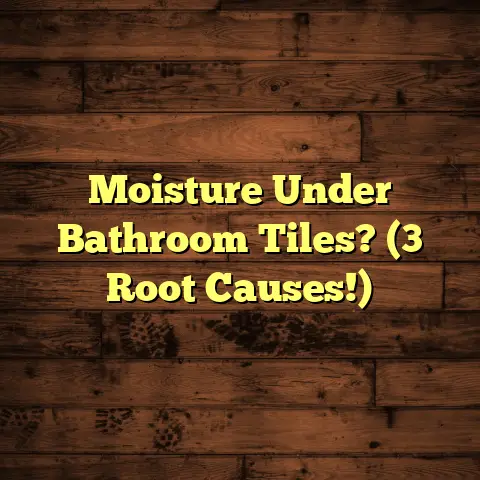Do You Need A Subfloor In Basement? (Explained)
I remember my early days as a flooring contractor when I tackled my first basement project.
I was brimming with excitement and confidence, but I made a critical mistake: I didn’t think about the subfloor.
The result?
A beautiful hardwood floor that warped and buckled over time, leaving my clients unhappy and my reputation at stake.
That experience taught me a valuable lesson: a subfloor is often essential for a successful basement flooring installation.
The Importance of a Subfloor
When it comes to basements, moisture is a major player.
Without proper moisture management, you risk damaging your flooring.
A subfloor acts as a barrier, helping to prevent moisture from seeping up through the concrete and ruining the floor above.
I’ve seen firsthand how moisture can wreak havoc on various flooring types, from laminate to hardwood.
Why Moisture Matters
Basement floors are typically made of concrete, which is naturally porous.
This means that moisture can easily seep through, especially during rainy seasons or in climates with high humidity.
If you install flooring directly on concrete without a subfloor, you run the risk of mold growth, warping, or even structural damage over time.
During a project in a suburban home, I observed how the lack of proper moisture barriers led to significant issues over the years.
The homeowners had installed laminate flooring directly over concrete without any subflooring.
Shortly after installation, they began noticing warping and gaps forming between the planks.
My First Basement Project
Let me take you back to that first project.
The basement was dark, damp, and had concrete floors that seemed to absorb every bit of humidity in the air.
I was eager to install beautiful oak hardwood, thinking it would transform the space.
But without a subfloor, the wood couldn’t handle the moisture, and I quickly learned that basements have unique challenges.
I decided to use a plywood subfloor, which is one of the most common choices.
The installation process involved laying down sheets of plywood over the concrete slab, using a moisture barrier to protect it.
It took me about three days to complete the project, including drying time for the adhesive used in the moisture barrier.
Facing Challenges
While I was pleased with the final look of the floor, I soon received complaints from the homeowners about creaking noises and gaps forming between planks.
After troubleshooting, I discovered that the lack of proper insulation and ventilation in the basement contributed to temperature fluctuations that affected the hardwood.
This experience taught me that not only is a subfloor necessary for moisture control, but also for creating a stable environment that minimizes movement in flooring materials.
Since then, I’ve always emphasized the importance of proper insulation along with the installation of a subfloor.
Choosing the Right Subfloor Material
There are several materials available for subfloors, each with its pros and cons.
Plywood
Plywood is the most common choice due to its affordability and ease of installation.
It’s strong and provides good support for various types of flooring.
Pros:
- Cost-effective
- Easy to cut and install
- Strong support
Cons:
- Can be prone to warping if exposed to excessive moisture
OSB (Oriented Strand Board)
OSB is another option that some contractors prefer.
It’s made from strands of wood pressed together with adhesives.
Pros:
- Generally cheaper than plywood
- Good structural strength
Cons:
- Less resistant to moisture compared to plywood
Concrete Board
For areas with high moisture levels, concrete board might be a wise choice.
It’s often used under tile installations but can serve as a durable subfloor as well.
Pros:
- Excellent moisture resistance
- Durable and stable
Cons:
- Heavier and harder to install
- More expensive than plywood or OSB
In my experience, plywood tends to be favored for most basement projects because it strikes a good balance between cost and performance.
However, I always assess the specific conditions of each job site before making a recommendation.
Comparing Subfloor Materials
Let’s take a closer look at how these materials stack up against each other in real-world applications:
- Plywood vs.
OSB: In a historical renovation project I worked on in an old Chicago building, we opted for OSB due to its lower cost.
However, once installed, we found it absorbed moisture more readily than we anticipated.
The homeowners reported increased creaking sounds in just a few months.
In contrast, when we used plywood in another basement renovation, it held up well despite similar humidity levels. - Concrete Board Use Cases: In a high-end bathroom renovation that included heated floors, we chose concrete board as our subfloor material due to its excellent water resistance.
It provided an ideal base for tile flooring while ensuring longevity against potential leaks.
Installation Steps for Subfloors
When installing a subfloor in a basement, there are several steps I always follow to ensure success:
- Moisture Assessment: Check for existing moisture issues before starting any work.
Use a moisture meter to gauge levels in both the concrete and surrounding air. - Proper Ventilation: Ensure the basement is well-ventilated to minimize humidity levels during and after installation.
- Use of Moisture Barriers: Always lay down a moisture barrier beneath the subfloor material.
This is crucial in preventing moisture from rising through the concrete. - Leave Expansion Gaps: When installing your subfloor, leave small gaps around the edges to allow for expansion and contraction due to temperature changes.
- Regular Checks: After installation, I recommend checking the moisture levels regularly to catch any potential problems before they escalate.
Cost Considerations
Budgeting for a subfloor can vary based on materials and installation complexity.
Let’s break it down:
- Plywood: Typically ranges from $1.50 to $3.00 per square foot.
- OSB: Generally costs between $1.00 and $2.50 per square foot.
- Concrete Board: Prices can soar up to $4.00 per square foot or more.
For an average-sized basement of about 1,000 square feet, you might spend:
- Plywood: $1,500 – $3,000
- OSB: $1,000 – $2,500
- Concrete Board: $4,000+
Using FloorTally has been invaluable in managing these estimates effectively.
It allows me to input local prices quickly and generate accurate budgets on-the-go.
This way, I can provide clients with realistic expectations and avoid surprises down the line.
Success Stories
I’ve had numerous successful projects since that first basement disaster.
One memorable instance was a large renovation where we installed bamboo flooring over a plywood subfloor in a basement in Chicago.
The homeowners wanted an eco-friendly option that could withstand moisture while providing an aesthetic appeal.
After ensuring proper insulation and ventilation alongside our moisture barrier, we completed the project within two weeks.
The final result was stunning, and the clients were thrilled with how warm and inviting their basement felt.
A Challenging Renovation Experience
Not every job goes smoothly; I’ve had my share of challenges as well.
In one particular project in Minnesota, we faced major setbacks due to unexpected water intrusion during heavy rainfall after we had already laid down the subfloor.
After discovering pools of water on top of our newly installed plywood subfloor, we immediately addressed the issue by installing additional drainage systems around the property’s foundation walls.
We had to remove the affected areas of plywood and dry everything thoroughly before reinstallation.
This taught me an important lesson about always being prepared for unexpected weather events—especially when working in basements prone to flooding or water issues.
Maintenance Tips for Subfloors
Once you’ve installed your subflooring system properly, there are several maintenance tips you should keep in mind:
- Regular Inspections: Periodically check for signs of moisture or damage in your basement space.
- Manage Humidity Levels: Use dehumidifiers during humid months to keep moisture levels in check.
- Seal Cracks in Concrete: If you notice any cracks forming in your concrete slab over time, seal them promptly to prevent water infiltration.
- Monitor Temperature Fluctuations: Keep an eye on temperature changes—extreme fluctuations can affect your flooring material over time.
- Educate Homeowners: If you’re working with clients directly, ensure they understand how to maintain their basement space effectively after installation.
Expanding Upon Flooring Options Above Subfloors
Now let’s touch on what kind of flooring works best when installed over these various subfloors.
Hardwood Flooring
Hardwood adds elegance but requires careful consideration due to potential moisture issues in basements:
- Installation Method: Nail-down or glue-down methods work best over plywood subfloors.
- Considerations: Always check humidity levels before choosing hardwood; it may not be suitable for high-moisture environments without adequate control measures.
Laminate Flooring
Laminate offers cost-effective solutions while mimicking wood aesthetics:
- Installation Method: Floating installation can work well over many subfloors.
- Considerations: Choose laminate specifically designed for high-moisture areas; typically labeled as water-resistant or waterproof.
Tile Flooring
Tile is an excellent choice for high-moisture environments:
- Installation Method: Requires cement backer board or concrete board as a subfloor base.
- Considerations: Ensure proper grout sealing after installation to prevent water seepage beneath tiles.
Carpet
Carpet may not be ideal for every basement but can provide warmth:
- Installation Method: Pad and carpet should be installed over suitable subfloor materials.
- Considerations: Always ensure adequate ventilation; carpets can trap moisture leading to mold growth if not managed properly.
The Role of Insulation
Insulation plays an essential role in maintaining temperature consistency within your basement environment:
Types of Insulation
- Foam Board Insulation: Rigid foam boards can be placed against concrete walls before installing subfloors.
- Spray Foam Insulation: Offers superior sealing against air leaks while providing excellent R-value (resistance value).
- Fiberglass Batts: Often used between framing studs; consider using vapor barriers with this type.
My Experience with Insulation
One memorable project involved insulating an old stone foundation before installing new floors over it.
We used fiberglass batts combined with foam board insulation along the walls to create an air-tight seal while minimizing heat loss during winter months—resulting in happier homeowners who appreciated their warmer basement!
Dealing with Unforeseen Issues
As with any job site, there will always be unexpected challenges that may arise during projects:
Water Intrusion Issues
While conducting renovations at another property near Lake Michigan last summer, we encountered significant water intrusion issues after heavy rainfall caused nearby flooding—forcing us into crisis mode!
The team quickly evaluated our options; we decided on installing French drains around the exterior perimeter while also utilizing sump pumps inside as added protection against excess rainfall moving forward.
Structural Concerns
Another project had underlying structural problems due to previous renovations done decades earlier without proper permits which led us down an uncertain path when assessing how best to proceed safely…
We engaged structural engineers who helped develop plans addressing these concerns without compromising quality throughout our renovations—ensuring long-term safety for occupants once completed!
Conclusion
In summary, do you need a subfloor in your basement?
Absolutely!
It’s essential for managing moisture and providing stability for your flooring choice.
When considering options or planning an installation, remember:
- Assess your specific conditions.
- Choose the appropriate materials.
- Don’t skip on moisture barriers.
- Use tools like FloorTally for accurate budgeting.
The right approach will lead to successful outcomes that satisfy both you and your clients while ensuring longevity for your floors.
Investing time in understanding these elements will pay off in creating beautiful spaces that stand the test of time.





